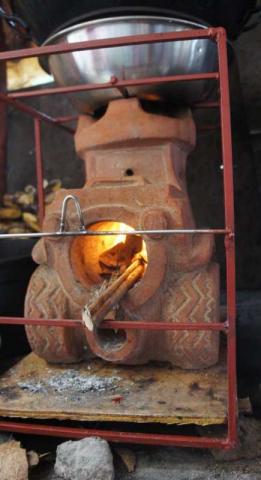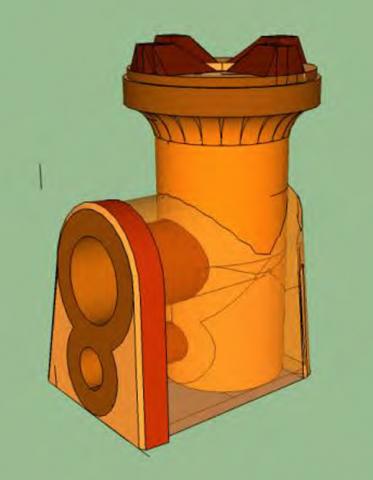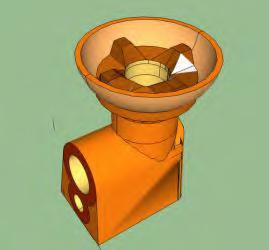by Joshua B. Guinto
Specialist, Sustainable Village Technologies
1 The Basic Mechanisms of the Rocket Stove. With the lessons from people like Rok Oblak, Richard Stanley and the Aprovecho Institute the author began learning to build the holey roket stove in his workshop at Daet, Camarines Norte. With sheer perseverance and amidst scarcity, he was able to create several models and delivered skills training to poor people in Camarines Norte, Sorsogon and recently in Bulacan.
2. Among the many feedbacks from the users are the limitation of the holey roket stove in terms of (1) fragility in handling and (2) capacity to receive bigger loads when cooking for bigger occasions and events and for food business. In response, one of the models was picked up for reinforcements.
3. The Innovations as of July 2013
- 3.1. The Holey Roket Stove has evolved to come with sculpted designs. The stove truck is only one of many models that the author was able to create.
- 3.2. The stove has a second barrel beneath the fuel feeder. This barrel serves two purposes. It is where the ash may be pulled out. It is also where an added boost of primary air comes in preheated. The hot char from the fire chamber should be allowed to stay inside the length of the second barrel until it turns into ash. With the hot char in the barrel, the incoming primary air will be preheated thus adds to the efficiency of the burn.
- 3.3. It comes with a metal frame of 10 mm square bars. Having
- the stove in a metal frame box achieves two things. First, it protects the stove from damage during transport. The stove is made from refractory clay, meaning it is not built for durability but instead for insulation and therefore much more fragile than a clay pot or a brick for construction. Second, it allows the use of bigger and heavier pots and woks for safety and for carrying the heavy load.
- 3.4. A metal pan (planggana) now serves as a skirt. The shape of the skirt allows the use of different sizes of pots and pans. The metal pan for this stove model costs Php 95. (The wok in the photo is extremely big for the skirt). It achieved the purpose of improving the contact of the flames to the walls of the wok. Furthermore, it also reduced the heat fatigue being experience by the cook in stoves that otherwise would not have a skirt.
- 3.5. A blower may be fixed to the front of the fuel feeder. The metal rod (please see photo) is upon which the blower may be connected. During the test, Maricris Tugade, the stall owner said she does not have access to electricity in her stall and so the test went on without the blower and she was very satisfied with the results just the same.
4. Results of Test. During the test in a banana cue stall in Daet in 27 July 2013, five hours of cooking for fifty (50) kilograms of banana consumed about eight kilogram of fuel consisting of coconut ribs, coco shells and wood sticks with a market value of Php 12. This was a big drop from the regular daily consumption of Php 150 daily for buying wood charcoal. One bag worth Pp 300 is consumed every two days. It will translate to a savings of Php 138 daily or Php 39,744 every year
Going further, with the assumption that one big tree would yield thirty six (36) bags of charcoal, this stove willtherefore save four (4) big trees every year for this stall alone.
Heavier kind of charcoal called barit is much preferred by the consumers like Maricris because of much higher heat output and the hot char stays longer before turning into ash. However barit is a kind of charcoal made from hardwoods which the charcoal producers chopped. Those hardwoods include narra, mahogany, yakal and dirigkalin.
To confirm this claim, the author, during his field research for his master’s thesis, went up to the forests of Barangay Bulala in Sta. Elena to observe the traditional practices of wood charcoal production. There he found several piles of huge dirigkalin logs ready for the carbonization.
For more informaiton, please see the attached pdf version of this report
Joshua B. Guinto is a development worker since 1987 and is at present a freelance consultant on village technologies. He followed his master’s program in 2006-2008 at the Wageningen University at the Netherlands under the sponsorship of the International Fellowships Programme of the Ford Foundation. He wrote his master’s thesis entitled Realistic Evaluation of Stove Design Process. His thesis led him to do field research in the stoves fabricators in many parts of the province including the wood charcoal producers of Bulala, Sta. Elena. PDF copy of his thesis is available upon request.



